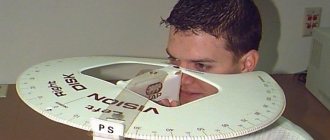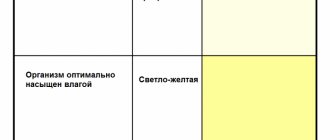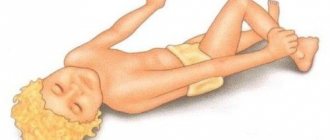Psychogenic shortness of breath - where does it come from?
Dyspnea is a disturbance in the frequency, rhythm and nature of breathing. There are pathological and nervous types.
With pathological shortness of breath, the cause lies in the disruption of the internal organs.
Psychogenic or nervous dyspnea develops primarily against the background of mental and nervous disorders:
- acute or chronic stress;
- psychogenic childhood - perhaps in childhood a person witnessed the occurrence of an attack of suffocation for various reasons. For example, a picture of drowning is accompanied by a convulsive swallowing of air by the drowning person, a characteristic facial expression;
- neurasthenia, neurosis, hysteria;
- depression;
- phobias, anxiety disorders;
- disorders of the autonomic nervous system – neurocirculatory dystonia;
- sleep disorders.
The symptom is difficulty breathing. It becomes superficial, with complicated short inhalations and long exhalations. His pace quickens, and even if a person manages to take a deep breath, it does not bring him much relief. This work of the lungs is called the breathing of a driven dog.
After uncontrolled accelerated respiratory movements there is a pause, and after it, convulsive breathing returns. All this causes anxiety and fear of approaching death in a person. A panic attack often occurs.
Distortion of the respiratory rhythm causes hyperventilation of the lungs and tension of the intercostal muscles. Because of this, false signs of angina pectoris and cardioneurosis develop. The patient is accompanied by weakness and malaise, excessive sweating, dizziness, cold extremities and convulsions.
Naturally, such symptoms suggest a heart disease, but it’s all about nervous tension.
Other signs of neurotic shortness of breath include:
- feeling of constriction in the chest;
- feeling of lack of air;
- control over the breathing process;
- feeling of a lump in the throat;
- attacks of neurotic cough - it becomes dry and annoying;
- nervous yawning;
- pain in the intercostal spaces;
- reflex movements to open the chest, which should help you take a breath - swinging your arms, straightening your shoulders, but they do not bring results;
- fear of death.
Nervous shortness of breath worsens a person’s mental state. It can cause depression, hypochondria, and mood disorders.
What to do to prevent episodes of shortness of breath due to dystonia?
It is worth starting with the formation of the right way of life. It is advised to separate work and rest, organize an action plan in such a way as to avoid stress and overwork as much as possible. A balanced diet and minimizing stimulants (coffee, alcohol, nicotine) will also help tidy up the nervous system.
Correcting your perception of reality will help you avoid panic attacks when difficulty breathing suddenly occurs. Psychotherapy sessions will help cope with excessive anxiety and prevent episodes of shallow breathing.
It is necessary to increase the functional reserves of the lungs, then it will not be difficult to breathe even with VSD. Training the respiratory system can be done independently or under the supervision of a specialist:
- running (the goal is 1 kilometer without shortness of breath; one of the most reliable and safe ways to correct the functioning of the respiratory system). If symptoms of breathing problems occur, you must immediately stop and normalize it. To achieve the effect you need 2-3 months of training. If there is no sports training, you should start with walking;
- sports (swimming, skiing, gymnastics). Supervision of a professional is required who will teach proper breathing for each type of load.
- autogenic training (self-conviction in the absence of problems with the respiratory system, requires long-term preparation to obtain an effect);
- breathing practices (yoga, qigong, holotropic breathing);
Exercises must be performed under the supervision of a competent instructor and approved by the attending physician.
Holotropic breathwork was used to produce a feeling of euphoria accompanied by hallucinations. Its effectiveness in VSD is not confirmed in every case. Doing breathing practices on your own can seriously harm your health.
If psychological techniques are insufficiently effective, medications are recommended. The doctor may prescribe mild herbal-based sedatives and, if necessary, tranquilizers. Shortness of breath with VSD will decrease after starting therapy: attacks will become less frequent and shorter, and may even stop altogether.
Development mechanism and distinction criteria
Each activity, including breathing, is regulated by a specific part of the brain. In a state of stress and nervous overstrain, the central and peripheral nervous systems fail. Control over the breathing center in the brain is lost, overexcitation spreads, resulting in faster breathing.
The lungs become overfilled with air, causing hypocapnia, that is, the amount of oxygen in the blood increases excessively, and carbon dioxide decreases below normal. This imbalance of gases causes an attack of psychogenic shortness of breath.
Despite the fact that the symptoms of its manifestation are similar to true shortness of breath, there are still some criteria that allow it to be differentiated:
| Types of shortness of breath Criteria | Psychogenic | True |
| Cause | Examination of internal organs fails to detect | Pathology of the heart, kidneys, lungs, etc. |
| Bodily symptoms | None | Pale or cyanotic skin, barrel chest, edema |
| Changing body position | Does not affect breathing pattern | A change in position can alleviate or provoke a pathological symptom. It often intensifies especially after physical activity. |
| Nature of violations | Fickle | Constant |
| Periodicity | It worsens due to the weather, at certain times of the day (for some, attacks occur in the morning, for others - at night). It appears more often in spring and autumn. | |
| Cough | Not controlled by medications | In some cases, it can be treated with medication |
| Switching attention | All symptoms go away if you move the conversation in a different direction | Shortness of breath persists, no connection |
How to treat asthma attacks?
Respiratory disorders can manifest themselves in different ways:
- episodes of rapid shallow breathing (caused by physical activity or anxiety);
- periodic dissatisfaction with the quality of inspiration, the need for deeper breathing movements, similar to yawns (may be accompanied by a feeling of weakness in the legs);
- neurotic asthma, with a respiratory rate of 30-50 breaths per minute (blood pressure and heart rate increase);
- respiratory crises (they are accompanied by dizziness, tachycardia, panic, cough, fear of suffocation and death).
If shortness of breath does not pose an immediate threat to the life and health of the patient, non-drug correction methods are first used. Since respiratory arrhythmia is psychogenic in nature, it is recommended to distract yourself from the current state, try not to focus on the problem and calm down. Then overexcitation in the cerebral cortex and the regulatory systems reporting to it will subside, and automatic correction mechanisms will bring the breathing rate back to normal.
If impaired breathing during VSD is dangerous to the patient’s health, the attack can be controlled with medications:
- tranquilizers (inhibit excessive activity of the nervous system).
- beta-blockers (remove symptoms of hyperfunction of the sympathoadrenal apparatus).
Preventing an attack is much easier, more effective and safer than stopping it.
Respiratory neurosis
There are many types of neuroses, each of which is distinguished by a specific group of symptoms. One of them is respiratory neurosis, which is characterized primarily by neurogenic breathing disorder.
The concept was introduced into use in 1871 by the American scientist Da Costa. It has several related names: “respiratory neurosis”, “neurorespiratory syndrome”, “respiratory dystonia”. But the term most often used is “hyperventilation syndrome” (HVS) . It accounts for approximately 10% of cases. Among the patients there are both children and adults. It is worth noting that women suffer from this disease several times more often than men.
The causes of the syndrome are divided into mental, organic, and mixed. Of course, the majority (about 60%) is due to psychogenic factors.
5% of cases include organic etiology. These include disorders of the structure of the central nervous system: encephalopathy, hydrocephalus, inflammation of the meninges, as well as diseases such as diabetes, hypertension, chronic bronchitis. Sometimes the reason is taking certain medications.
During the course of the disease, there are 3 groups of signs:
- respiratory;
- psycho-emotional;
- muscular.
Group I has several forms of manifestations:
- Empty breathing is a feeling of lack of air, its pace quickens.
- It seems that air is forced into the lungs, and there is a lump in the throat. Accessory muscles are involved in the respiratory act.
- A premonition of breathing stopping appears, and the person is forced to control its process by consciously inhaling.
- Yawning, moaning, sighing.
Group II symptoms include nervous tension and concern about one’s condition. The patient cannot relax. He develops phobias, in particular, a fear of open areas and places with large crowds of people.
Symptomatic group III includes muscle hypertonicity, various tactile sensations in the form of tingling, burning, and “goosebumps.”
This triad of symptoms is a typical, leading manifestation of the disease.
The disease is characterized by a chronic course, in which exacerbations occur.
An exacerbation of hyperventilation syndrome is called a hyperventilation crisis. This is a condition in which the manifestations of the disease intensify. Characterized by an increased sense of fear. The patient is suffocating, hysterical, and feels “near death.” At the same time, he is accompanied by chills, dizziness, nausea, and becomes covered in sticky cold sweat.
A crisis is caused by a negative psychological environment. A unique way to relieve an attack is to breathe into a bag. In this case, carbon dioxide is concentrated in it, which the neurotic inhales. Gas balance is restored, breathing is leveled out. This is the first aid in this situation.
As for children, they are also characterized by such a pathology as respiratory neurosis, which is also caused by stress, phobias and anxiety disorders. But it is worth noting that the main role in their occurrence is played by an unfavorable situation in the family, and this applies not only to rude and inadequate attitude towards the child, but also to the relationship between parents. Constant quarrels and conflicts in the family, aggression can provoke the development of psychogenic shortness of breath in children.
Such children are characterized by anxiety and lability (instability) of mood. They experience outbursts of anger over trifles, general nervousness, refusal to communicate with friends, and sleep disturbances.
Parents should be more vigilant and sensitive in raising their children.
Psychogenic asthma
In general, bronchial asthma refers to a pathology of the respiratory system. Its development is associated with changes in the structure of the bronchi against the background of immune failures, that is, it is a very specific disease, the etiology of which is not related to mental factors.
People suffering from this disease may develop a condition called psychogenic asthma. This happens when attacks of suffocation, the main symptom of the disease, are provoked by nervous overstrain, both positive and negative, whereas in normal cases this occurs under the influence of cold, infections or physical exertion.
Under the influence of super-emotions, histamine is released. This is one of the main mediators of inflammation. It causes bronchospasm. The result is a dry cough, shortness of breath and an attack of suffocation.
Psychogenic asthma often develops in women during the menstrual period and in children, whose psyche is still quite unstable and very sensitive.
How is it detected?
If you experience symptoms of shortness of breath, you should consult a doctor. First of all, he must check whether the symptom is a sign of physical pathology. To do this, the doctor conducts a survey of the patient, and then proceeds to an objective examination: examines and listens to the patient.
To exclude diseases of internal organs, a number of examinations are prescribed:
- radiography;
- allergy tests;
- CT or MRI;
- ECG, ultrasound of the heart;
- UAC.
Without identifying pathology, the doctor sends the patient to a neurologist or psychotherapist.
The psychotherapist collects a psychogenic history, which includes information about the presence of mental disorders, possible traumatic factors, as well as developmental features in childhood.
Psychological analysis involves the study of personality, including through testing. The Nymigen questionnaire is especially effective, being effective in 90% of cases. It was developed by Dutch pulmonologists. Includes 16 positions characterizing the signs of hot water supply. Their severity is assessed within 0-4 points.
During the neurological examination, neurological symptoms are checked and excessive sweating of the palms and feet is determined. Electromyography may be performed.
Additional examinations include hyperventilation test, acid-base blood test, and electrolyte balance. As a rule, with neurogenic shortness of breath, a deficiency of magnesium and calcium in the blood is detected.
How to get rid of the feeling of suffocation
The question of how to treat psychogenic dyspnea includes a wide range of methods.
But the main thing is to restore a favorable psychological background. Only nervous calm will help eradicate the disease completely.
You can try to do this on your own.
- Take herbal infusions.
- Set up a daily routine. Sleep – at least 8 hours. Avoid overwork.
- Give up bad habits, as they produce a psychostimulating effect.
- Workout.
- Proper nutrition - more fruits and vegetables, less fatty, salty and spicy foods. It would be good to diversify the menu with products high in magnesium: pumpkin and sunflower seeds, nuts, wheat bran, dates, spinach, cocoa.
- Warm flavored, massage, hardening.
- Breathing exercises – helps to increase the level of CO2 in the blood and reduce the breathing rate.
It happens that neurogenic breathing disorder goes away on its own. For this, a change in the situation was enough, both in a positive and negative direction.
Here is the story of a guy who suffered from nervous shortness of breath for a long time and got rid of it without noticing it. The young man suffered from the disease for 6 years, starting at the age of 15. Attacks of suffocation plagued him so much that he was afraid to go outside for fear of suffocating. After a long examination, a diagnosis was made: “hyperventilation syndrome.”
Upon reaching conscription age, he was drafted into the army (he turned out to be fit). This fact added even more panic. The service was akin to hell. But six months later he suddenly realized that the attacks had subsided. He could finally breathe deeply. There was a feeling that a second wind had opened, and for him it was on the verge of bliss. The disease no longer bothered him.
If you cannot cope with the disease on your own, you will have to resort to the help of specialists and medications.
- Psychotherapy.
- Prescription of sedatives, antidepressants and tranquilizers. Vitamins B, D, magnesium and calcium preparations, as well as beta blockers.
- Special devices that train breathing and help normalize its rhythm. They restore respiratory frequency and relax muscles. Therapy takes place in the form of a game, allowing you to develop self-control, improve your psycho-emotional background, and increase resistance to stress factors.
- Physiotherapy – magnetic therapy, electrophoresis, galvanization, mud therapy.
- Sanatorium-resort holiday.
Nervous shortness of breath, while not a sign of physical pathology, is nevertheless dangerous to health. Its occurrence requires immediate therapeutic intervention to prevent persistent mental disorders and personality changes.
Treatment options
Treatment of respiratory neurosis requires complex therapy with medications and psychotherapeutic methods in combination with breathing exercises:
- Working with a psychotherapist . The main task is to teach the patient to quickly take control of his own emotions, without allowing them to dominate the intellectual assessment of the situation and become a stressful event. The best results for solving this problem are demonstrated by cognitive behavioral therapy.
2. Taking antidepressants . Helps reduce the intensity of negative experiences, depression, anxiety and more. Only the attending physician can prescribe a specific type of antidepressant. 3. Electrolyte balance . It is ensured by taking magnesium and calcium supplements. 4. Hardware therapy . Using special equipment, patients are taught how to control physiological processes such as breathing rate and muscle relaxation. 5. Breathing exercises . Developing correct breathing skills by regularly performing special breathing exercises.
Supportive techniques include physiotherapy, relaxing baths, autogenic training and general health spa treatment.
First aid for acute respiratory neurosis
Separately, 4 rules of first aid for the development of acute hyperventilation syndrome should be described:
- Allow the patient to breathe in a paper or plastic bag. By inhaling his own CO₂, the patient increases the level of carbon dioxide in the blood, which allows the blood pH level to remain normal.
- Reassure the patient to the extent that the situation allows.
- Provide a visual flow of fresh air - for example, open the windows wide (this is very calming for many).
- If the patient has previously undergone a course of psychotherapy and breathing exercises as part of the complex treatment of DN, remind him what to do, since in a moment of panic, some patients forget to use the skills they have learned.










